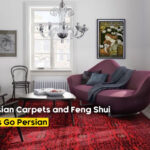
How Persian Carpets Enhance Feng Shui in Your Home

The Role of Persian Carpets in Global Trade History
Persian carpets are celebrated around the world for their intricate designs, rich history, and exceptional craftsmanship. One of the most important aspects of a Persian carpet’s quality is its weaving technique. The type of weave not only determines the durability of the carpet but also influences the intricacy of its design and the texture of its surface. Each weaving style is deeply rooted in the regional traditions of Iran, with different areas favoring distinct techniques. In this guide, we will explore the most common types of Persian carpet weaves, from hand-knotted to flat-weaves, and discuss their unique characteristics, helping you understand the craftsmanship behind each masterpiece.
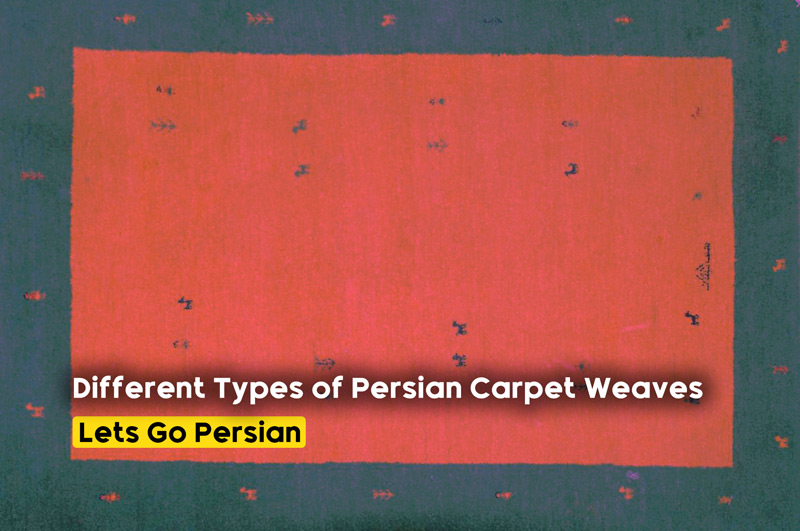
A Guide to Different Types of Persian Carpet Weaves
1. Hand-knotted weave (Pile Carpets)
Overview of Hand-Knotted Carpets
The most famous and highly regarded type of Persian carpet is the hand-knotted pile carpet. These carpets are made by tying individual knots around the warp threads of the loom. The number of knots per square inch (KPSI) is a key factor in determining the carpet’s quality—higher knot density allows for more intricate designs and greater durability.
Types of Knots in Persian Carpets
Persian carpets typically use two main types of knots: the Persian knot (also known as the asymmetrical knot) and the Turkish knot (also called the symmetrical knot). The type of knot used depends on the region and the specific weaving tradition of the area.
- Persian Knot (Asymmetrical Knot): This knot is more common in central and southern Iran and allows for greater detail and finer patterns. The knot is tied around one warp thread and passes loosely under the adjacent warp, giving it a less bulky appearance. This knot is ideal for intricate floral and curvilinear designs.
- Turkish Knot (Symmetrical Knot): Predominantly used in northwestern Iran, particularly in Tabriz and Kurdish regions, this knot is tied around two warp threads, creating a more durable and dense weave. It is well-suited for geometric and tribal designs.
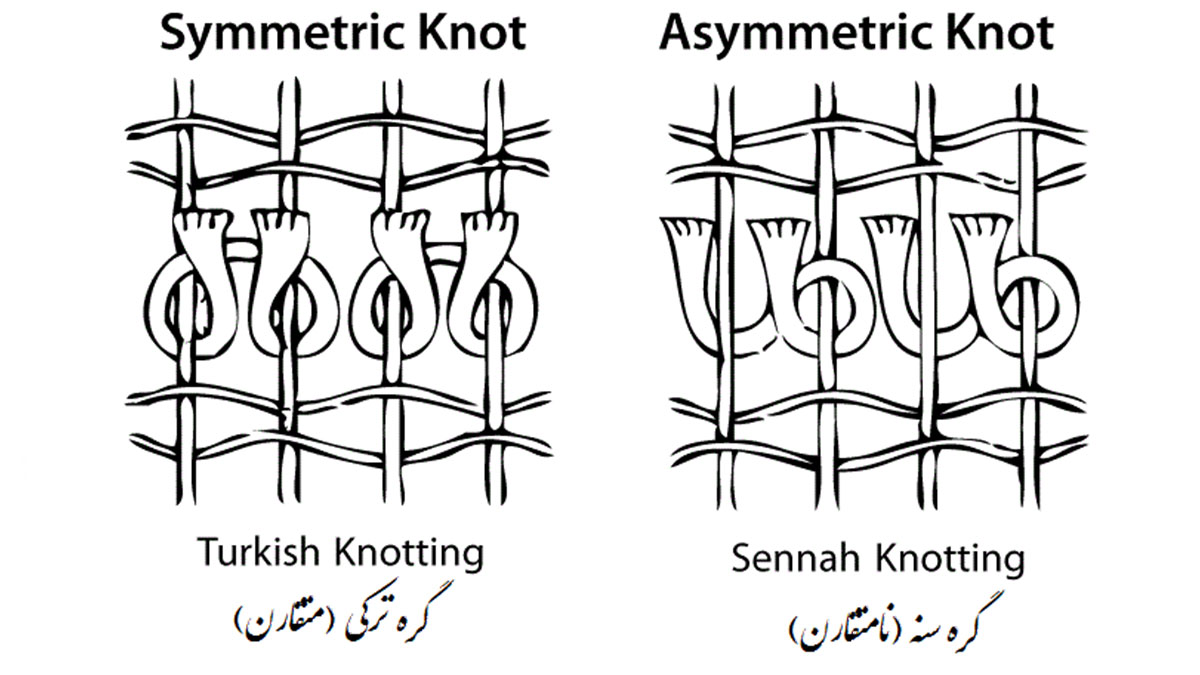
Knotting Techniques
Examples of Hand-Knotted Persian Carpets
- Tabriz Carpets: Known for their fine knotting and detailed patterns, Tabriz carpets often feature central medallions, intricate floral motifs, and sophisticated landscape scenes. They are typically woven with Persian knots.
- Kashan Carpets: Famous for their high knot density, Kashan carpets are known for elegant floral and medallion designs, often woven with wool and silk. The Persian knot is predominantly used in these carpets.
2. Flat-Weave (Kilims and Soumak)
Overview of Flat-Weave Carpets
Unlike hand-knotted carpets, flat-weave carpets such as Kilims and Soumak do not have a pile. Instead, these carpets are woven by interlocking the warp and weft threads, creating a smooth, flat surface. Flat-weave carpets are lighter, more flexible, and are known for their bold geometric patterns and tribal designs.
Kilims: Simplicity and Bold Geometric Designs
Kilims are one of the oldest and most traditional types of Persian flat-weave carpets. They are created by weaving the weft threads tightly through the warp threads, resulting in a flat surface with no knots. The weft threads form the visible pattern, making Kilims reversible.
- Geometric Patterns: Kilims are often decorated with tribal geometric designs, such as diamonds, triangles, and zigzags. These patterns are rich in symbolism, representing themes of protection, fertility, and spiritual beliefs.
- Bright Colors: Kilims are known for their vibrant colors, traditionally derived from natural dyes, which add boldness to the geometric patterns. Colors like red, blue, green, and orange are frequently used.
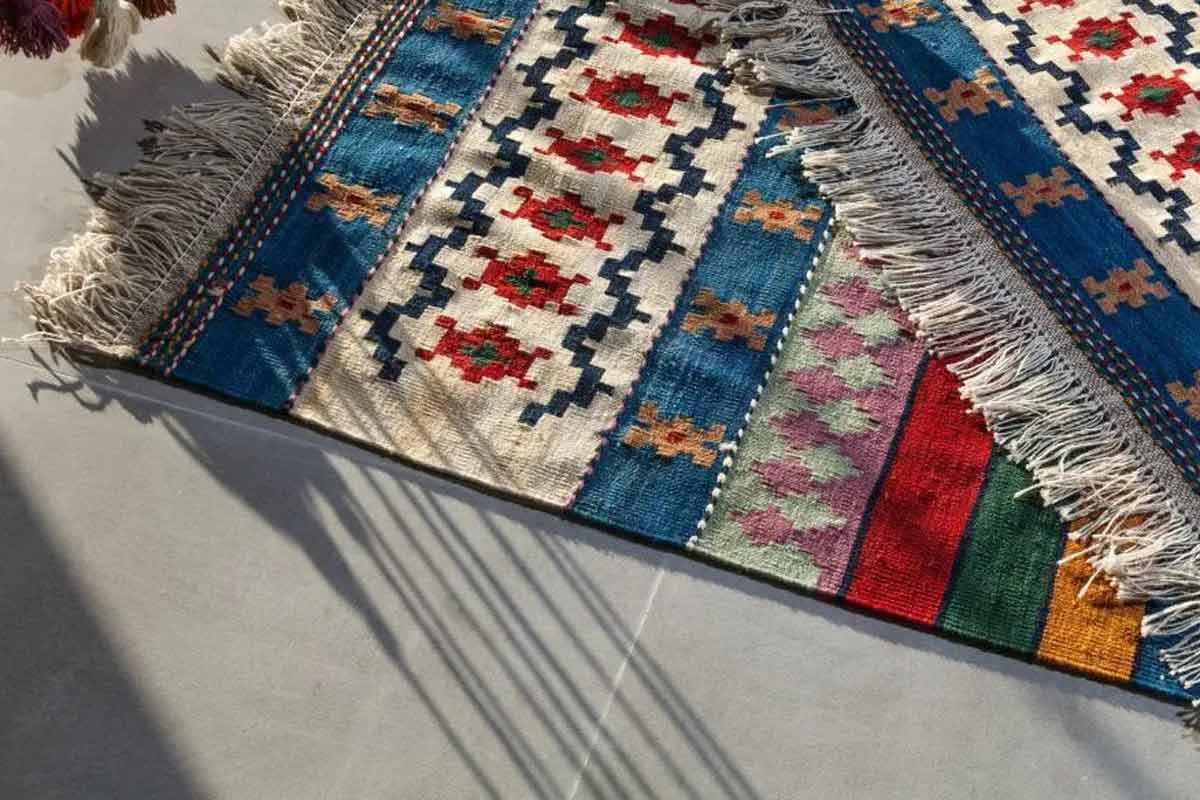
Persian Kilim
Soumak: Textured Flat-Weave
Soumak is a type of flat-weave carpet that differs from Kilims in that it has a textured surface. In Soumak weaving, additional weft threads are twisted around the warp threads in a way that creates a raised pattern, giving the carpet a distinctive texture and making it more durable than Kilims.
- Durability: Soumak carpets are thicker and more durable than Kilims, making them ideal for high-traffic areas. The weaving technique creates a more substantial fabric, though it remains flat without a pile.
- Pattern Complexity: Soumak carpets often feature intricate geometric and floral designs, combining tribal motifs with detailed artistry.
Examples of Flat-Weave Carpets
- Shiraz Kilims: Woven by the nomadic tribes of southern Iran, Shiraz Kilims are known for their bold geometric patterns and rich colors. They often feature symbols of nature and animals.
- Caucasian Soumak: Though originating from the Caucasus region, Soumak weaving is also practiced in northern Iran. These carpets are known for their complex patterns and thick, textured weave, making them both visually striking and highly durable.
3. Gabbeh Weave: The Rustic and Primitive Look
Overview of Gabbeh Carpets
Gabbeh carpets are a type of hand-knotted Persian rug that originates from the Qashqai and Luri tribes of southern Iran. They are known for their coarse weave, thick pile, and simple designs. Unlike the finely detailed carpets from cities like Tabriz and Isfahan, Gabbeh carpets have a rustic, almost primitive charm, often featuring minimalistic patterns or abstract shapes.
- Coarse Weave: Gabbeh carpets are characterized by their low knot density, with fewer knots per square inch. This results in a more rugged and less detailed design, which is part of their unique appeal.
- Simple and Abstract Designs: Gabbeh carpets often feature simple, abstract motifs, such as animals, plants, or human figures, and are typically woven in earthy tones. The design may include large, solid-color blocks or basic geometric shapes.
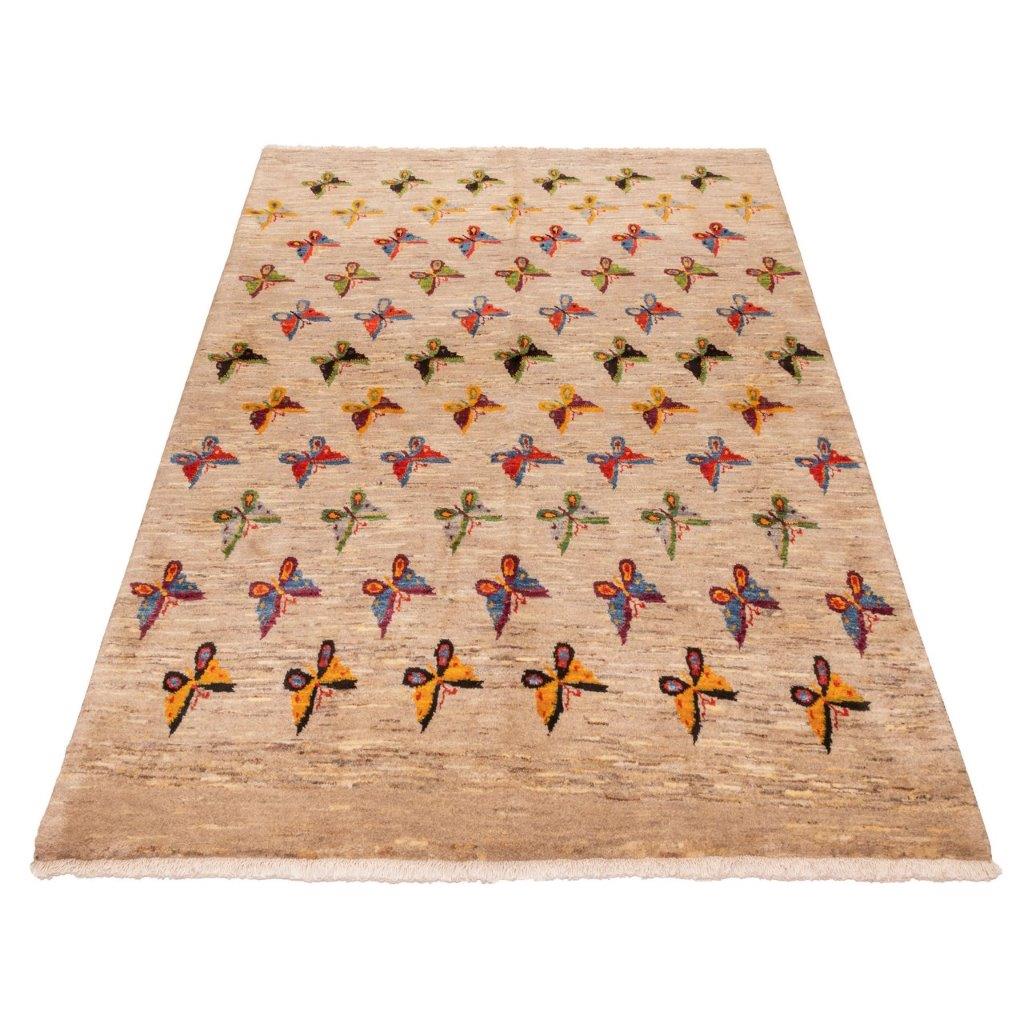
Gabbeh
Symbolism in Gabbeh Carpets
Gabbeh weavers, typically women from nomadic tribes, often incorporate personal stories and tribal symbolism into their carpets. The designs are often spontaneous and reflective of their surroundings, such as the animals they herd or the landscapes they inhabit.
Examples of Gabbeh Carpets
- Qashqai Gabbeh: Woven by the Qashqai tribe, these Gabbeh carpets often feature bold, abstract shapes with vibrant colors, such as deep reds, blues, and yellows. The designs are typically minimalist, with large blocks of color.
- Luri Gabbeh: Luri Gabbeh carpets are known for their earthy colors and simple, organic patterns. They often feature symbolic representations of animals and plants, reflecting the weaver’s connection to nature.
4. Baluch Weave: Tribal and Nomadic Artistry
Overview of Baluch Carpets
Baluch carpets are woven by the Baluchi nomads in eastern Iran, near the borders of Afghanistan and Pakistan. These carpets are typically smaller in size, reflecting the nomadic lifestyle of the weavers, and they often feature dark, rich colors and tribal designs.
- Dark Color Palette: Baluch carpets are known for their deep, rich colors, such as dark reds, browns, and blacks, which are often contrasted with brighter accents like blue or orange.
- Tribal Motifs: The designs in Baluch carpets are typically geometric, with diamond and octagonal shapes being common motifs. The patterns often reflect the weavers’ tribal identity and incorporate elements from their environment.
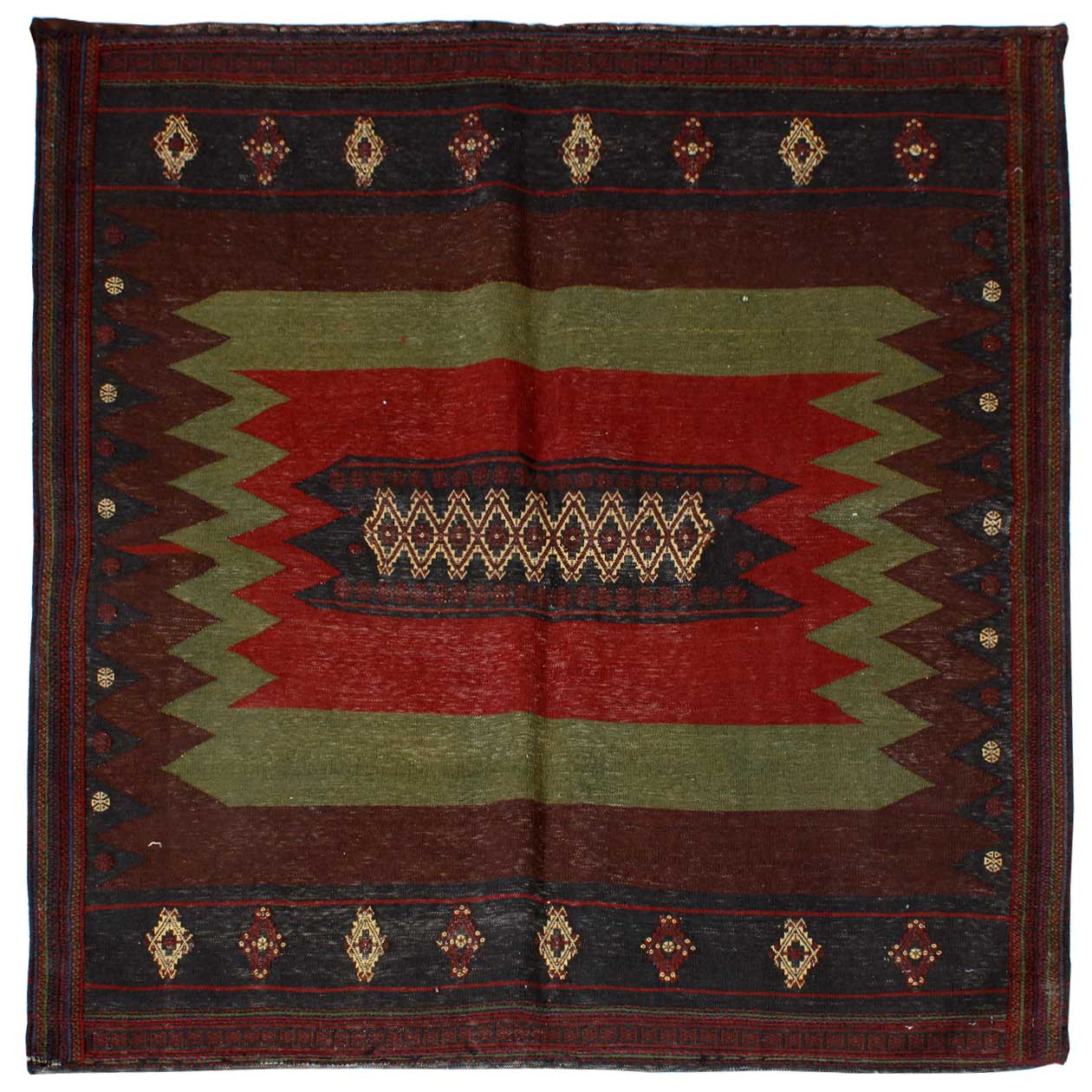
Baluch Weave
Durability and Use
Baluch carpets are known for their durability and are often used as prayer rugs or for everyday use by the nomads. Their compact size and durable weave make them highly portable and practical for nomadic living.
Examples of Baluch Carpets
- Baluch Prayer Rugs: These rugs often feature a Mihrab design, which is a prayer niche that helps guide the faithful in the direction of Mecca. The simple yet symbolic designs are a hallmark of Baluch craftsmanship.
- Baluchi Saddle Bags: In addition to carpets, the Baluch tribe also weaves saddle bags and other functional textiles using the same techniques. These items often feature the same bold, geometric patterns as their carpets.
5. Qom Weave: Fineness and Silk Luxury
Overview of Qom Carpets
Qom carpets are known for their extremely fine craftsmanship and are often woven using silk or a combination of wool and silk. These carpets come from the city of Qom in central Iran and are considered some of the most luxurious Persian carpets, known for their high knot density and detailed, intricate patterns.
- Silk Carpets: Many Qom carpets are woven entirely from silk, giving them a lustrous sheen and an exceptionally soft texture. Silk allows weavers to achieve incredibly fine details in their designs.
- Fine Knotting: With a very high knot density, often exceeding 600 knots per square inch, Qom carpets are renowned for their intricate patterns, which typically feature floral motifs, medallions, and garden designs.

Qom Carpet
Symbolism in Qom Carpets
Qom carpets often feature intricate floral patterns and garden scenes, symbolizing paradise and eternal beauty. The detailed designs reflect the weaver’s dedication to perfection and artistry.
Examples of Qom Carpets
- Silk Qom Carpets: These luxurious carpets are known for their sheen and highly detailed floral designs, often featuring central medallions and borders filled with flowers and vines.
- Wool and Silk Blends: Carpets woven with a combination of wool and silk are common in Qom, with silk used to highlight details and add texture to the designs.
Conclusion
Persian carpets come in a wide variety of weaving techniques, each offering its unique characteristics and artistry. From the finely knotted Qom silk carpets to the boldly patterned Baluch rugs, the type of weave plays a significant role in the overall appearance, durability, and symbolism of the carpet. Whether you prefer the elegance of a hand-knotted carpet, the tribal charm of a Kilim, or the luxury of a silk Qom rug, understanding the different types of Persian weaves will help you appreciate the craftsmanship and cultural significance behind each piece.



















